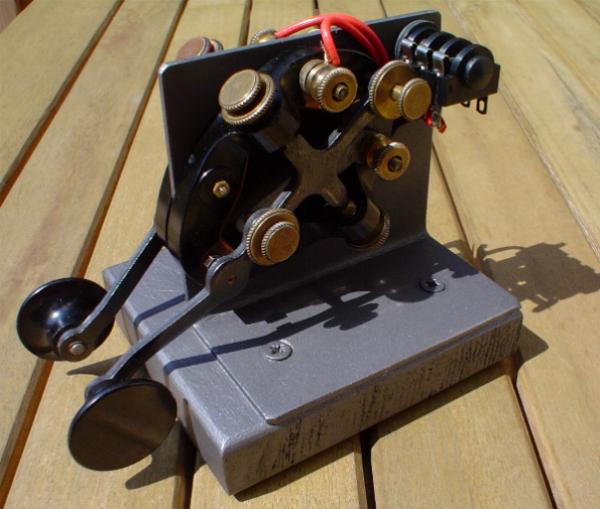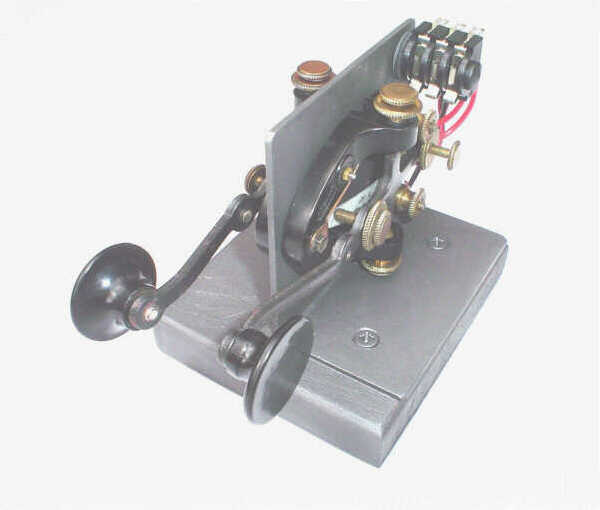PA3CLQ's keys.
Jan Pieter Oelp, PA3CLQ, Silent Key.
It is with great sadness that we announce that:
Our good friend Jan Pieter, PA3CLQ, has become a Silent Key.
Jan Pieter Oelp, PA3CLQ, passed away on Tuesday July 16, 2019.
Jan Pieter was the very first Dutch operator to join the SSN group, nearly 20 Years ago.
He was the editor of the PLL bulletins, a very interesting email newsletter devoted to all aspects of Morse code and sent to thousands of subscribers from all over the world.
Jan Pieter will be greatly missed.
Our deepest sympathy to Jan Pieter Oelp's family and friends.
Homebrew sideswiper 1.
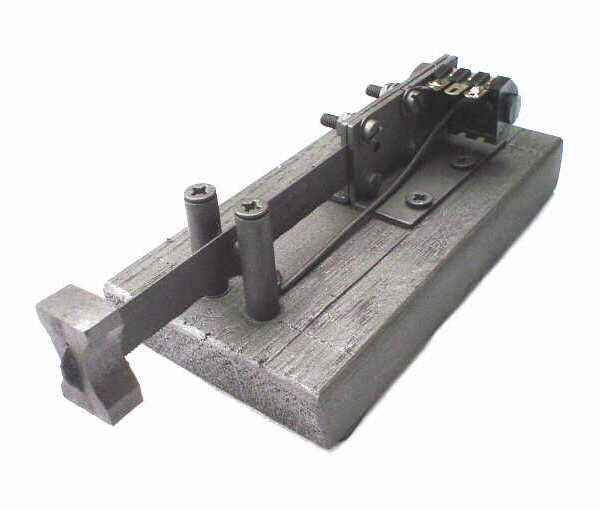 This homebrew sideswiper is built around a piece of hacksaw blade. Two silver contacts from an old relay are soldered on the blade. The contact posts consist of two short pieces of 8 mm diameter copper tubing. Contact spacing and spring tension are not adjustable. I can send code at 20 WPM with this key. I first thought that the part of the blade between contact posts and the paddle (Button) was too long: the lever having too much travel, the action would be spongy. After many thousands of QSOs with this SSK I have the experience that this is beneficial. The curvature of the blade with the left / right motion takes a small amount of time. This provides a smoother 1:3 ratio. With a stiff lever, the risk of "paste" is greater.
[PA3CLQ].
This homebrew sideswiper is built around a piece of hacksaw blade. Two silver contacts from an old relay are soldered on the blade. The contact posts consist of two short pieces of 8 mm diameter copper tubing. Contact spacing and spring tension are not adjustable. I can send code at 20 WPM with this key. I first thought that the part of the blade between contact posts and the paddle (Button) was too long: the lever having too much travel, the action would be spongy. After many thousands of QSOs with this SSK I have the experience that this is beneficial. The curvature of the blade with the left / right motion takes a small amount of time. This provides a smoother 1:3 ratio. With a stiff lever, the risk of "paste" is greater.
[PA3CLQ].
Homebrew sideswiper 2.
This homebrew sideswiper consists of two US military J-37 keys mounted back-to-back and bolt together on an aluminum "L" bracket. This assembly is fixed to a hard wooden base. Contacts are wired in parallel to get a cootie circuit. Picture 1 shows the original version, I modified the key to get the handles a bit lower to the desk by placing the two keys at a 45 degree angle, see picture 2. With a wide contact spacing and a firm spring tension, a speed of 20 WPM is feasible with this key. For further details, read Jerry's, KD0CA, recommendations in his article:
"The Art of Side-Swipery."
[PA3CLQ].
Homebrew sideswiper 3.
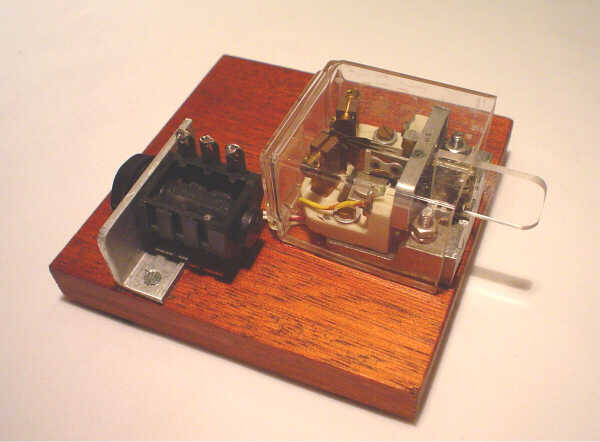 I built this mini paddle in 1985, it is made from an old polar relay. I've made lots of contacts with this key, it can be hooked up to an electronic keyer but it works fine as a sideswiper.
[PA3CLQ].
I built this mini paddle in 1985, it is made from an old polar relay. I've made lots of contacts with this key, it can be hooked up to an electronic keyer but it works fine as a sideswiper.
[PA3CLQ].
KENT Single Paddle Key.
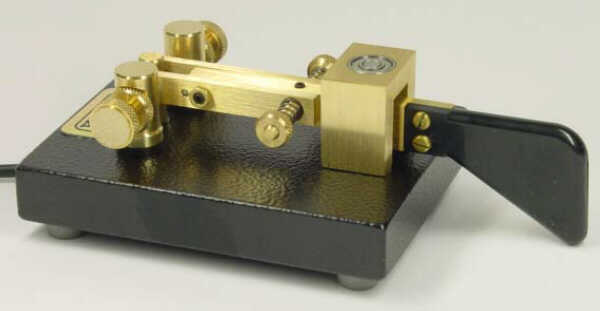 A well made and robust key, excellent feel used as a sideswiper. For detailed information:
A well made and robust key, excellent feel used as a sideswiper. For detailed information:
Visit the manufacturer's page.
[PA3CLQ].
Sideswiper made by PA4NIC.
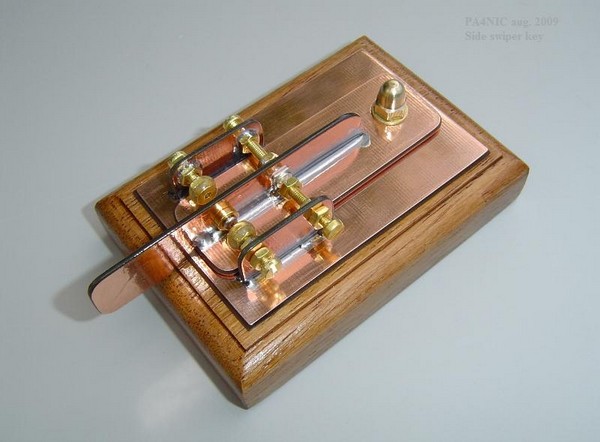 The Nico Vermeer home made Sideswiper is made of printed circuit board pieces. On the right side of the picture is a hidden sealed ball bearing unit which is hidden from view by the pivoting horizontal circuit board and the lower larger stationary circuit board. This larger circuit board is attached to the wooden block base by glue. The lower piece of circuit board does not move and has been drilled to expose the sealed ball bearing.
The Nico Vermeer home made Sideswiper is made of printed circuit board pieces. On the right side of the picture is a hidden sealed ball bearing unit which is hidden from view by the pivoting horizontal circuit board and the lower larger stationary circuit board. This larger circuit board is attached to the wooden block base by glue. The lower piece of circuit board does not move and has been drilled to expose the sealed ball bearing.
The pivoting horizontal circuit board attaches to the sealed ball bearing and is secured by an acorn shaped nut and small threaded rod. This light weight pivoting horizontal circuit board moves freely because it turns on the sealed ball bearing.
Near the operator are two magnets which provide tension on the lever, no metal springs are used or needed. There are two sets of adjustment bolts and nuts. One set adjusts the contact spacing of the lever and the other set adjusts the magnetic tension of the lever. Each side of the lever has independent tension and spacing adjustments which the operator can adjust to his needs and preferences to produce clear and effortless keying of Morse code.
A nice piece of work.
Some construction details.
PA4NIC's Web Site.
[PA3CLQ].
Modified Vibroplex VibroKeyer.
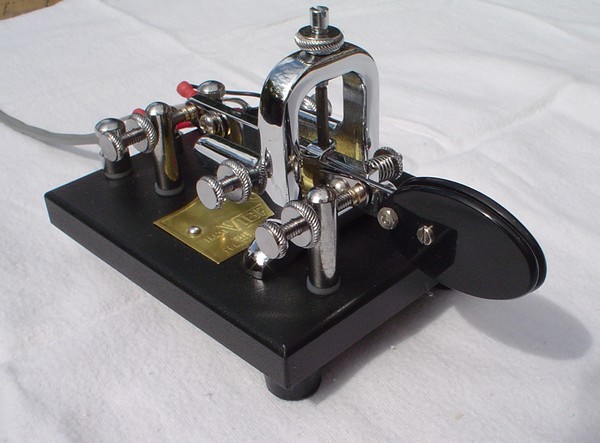 I replaced the original knob and paddle with a set of two thumb finger pieces to get a better cootie feel and appearance. My observations regarding this key when used as a sideswiper are identical to those made by the other VibroKeyer users.
[PA3CLQ].
I replaced the original knob and paddle with a set of two thumb finger pieces to get a better cootie feel and appearance. My observations regarding this key when used as a sideswiper are identical to those made by the other VibroKeyer users.
[PA3CLQ].
Bunnell Double Speed Key on hard wooden base.
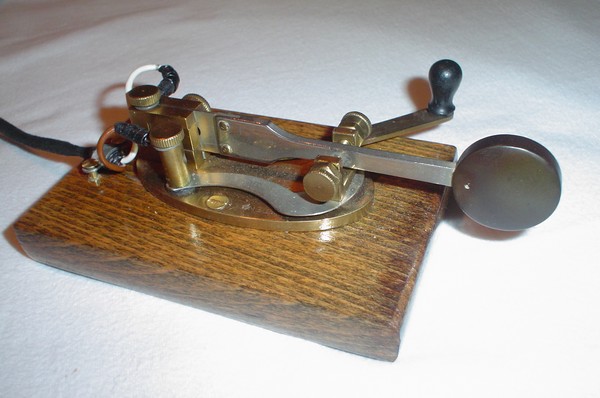 I have mounted the key on a hard wooden base. I've used old style brass screws and an old cotton covered cable to match the vintage of the key. In order to get a smoother action, the contact spacing has been reduced to 2X0.175mm. With a wider contact spacing the tension of the blade appears to be too high to obtain a comfortable action. At first, I found the feel of the movement of this key somewhat stiff but after a short period of practice, the lever action turned out to be very smooth. I send at 25 WPM for casual contacts and a bit faster in contests. I really enjoy using this sideswiper, it has become my favorite sending instrument.
[PA3CLQ].
I have mounted the key on a hard wooden base. I've used old style brass screws and an old cotton covered cable to match the vintage of the key. In order to get a smoother action, the contact spacing has been reduced to 2X0.175mm. With a wider contact spacing the tension of the blade appears to be too high to obtain a comfortable action. At first, I found the feel of the movement of this key somewhat stiff but after a short period of practice, the lever action turned out to be very smooth. I send at 25 WPM for casual contacts and a bit faster in contests. I really enjoy using this sideswiper, it has become my favorite sending instrument.
[PA3CLQ].
LNR Precision SKCC Cootie.
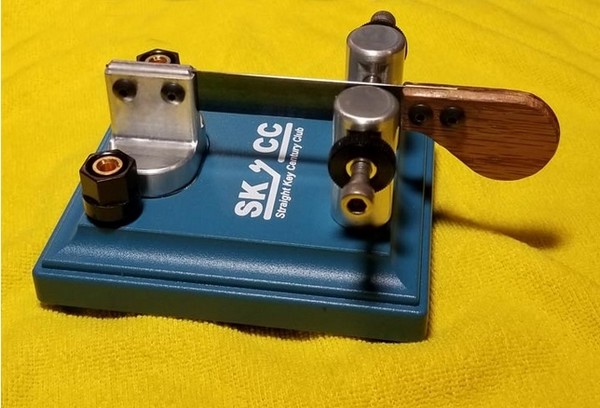 The lever is made of stainless steel also the contact screws this causes a scratching sound after some time. I'm going to replace the stainless steel screws with brass screws and hope this is an improvement. Another option is to drill an axial hole in the stainless steel screws and attach a 1 mm brass wire nail...
[PA3CLQ].
The lever is made of stainless steel also the contact screws this causes a scratching sound after some time. I'm going to replace the stainless steel screws with brass screws and hope this is an improvement. Another option is to drill an axial hole in the stainless steel screws and attach a 1 mm brass wire nail...
[PA3CLQ].
